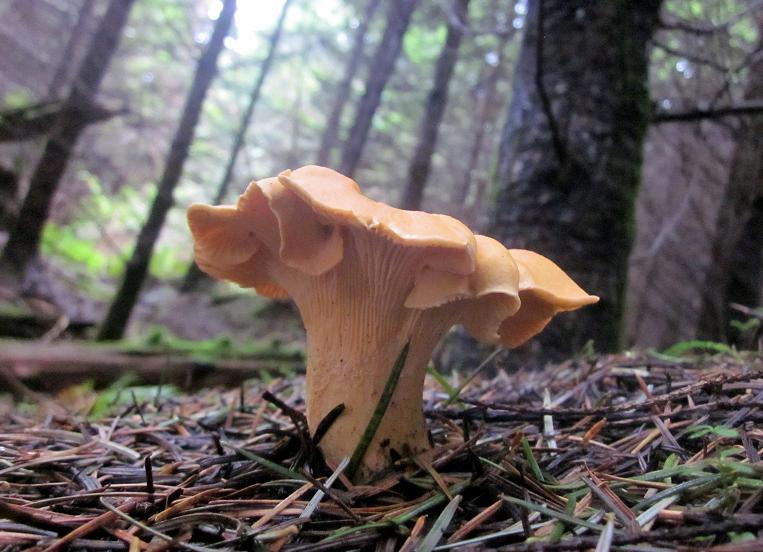 It’s autumn, there’s no doubt about it now. The skies have darkened to the gunmetal grey colour we all know so well. The mornings are too cold to roam the backyard in shorts… Back to my ratty jeans, I guess. I can see the steam of my morning coffee rising against the bitter chill with an almost audible hiss. The leaves play a staccato beat in the greenbelt as they fall, hitting every brittle branch on their way to the mushy floor. And the rain… oh, the rain completes the autumn ensemble by punishing the gutters with waves of smooth and freestyle jazz arrangements in the key of dank.
It’s autumn, there’s no doubt about it now. The skies have darkened to the gunmetal grey colour we all know so well. The mornings are too cold to roam the backyard in shorts… Back to my ratty jeans, I guess. I can see the steam of my morning coffee rising against the bitter chill with an almost audible hiss. The leaves play a staccato beat in the greenbelt as they fall, hitting every brittle branch on their way to the mushy floor. And the rain… oh, the rain completes the autumn ensemble by punishing the gutters with waves of smooth and freestyle jazz arrangements in the key of dank.
I couldn’t be happier.
Don’t tell Crystal I said so, but I love autumn way more than summer. And one of the main reasons why is ‘cause of all the perks we West coasters get from foraging in this dark, damp season. The rains bring good things my friends, as Saint
I’m speaking of course, of fungus. Wild mushrooms are damn near everywhere during this time of year. The long weeks of rain and intermittent crisp sunshine create whole forests of pudpods both edible and toxic. If you know the right people, and have a couple hours free to ramble around in the muck, it’s possible to carry your weight in golden chanterelle mushrooms home for dinner. Even if you are just a soggy novice forager like me.
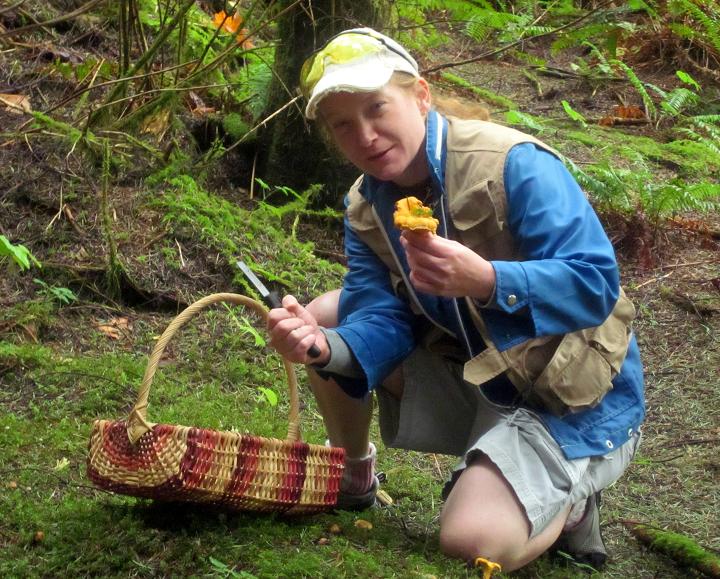 Luckily, I know some pretty amazing people. Like Obi-Wan Toni who has already lent her vast foraging knowledge to many past posts and inspired me to try more new ingredients and recipes than I can count. When she asked me if I wanted to go out into the bush and hunt for chanterelles, I didn’t hesitate… Even when she suggested getting up at 8:00am on my day off.
Luckily, I know some pretty amazing people. Like Obi-Wan Toni who has already lent her vast foraging knowledge to many past posts and inspired me to try more new ingredients and recipes than I can count. When she asked me if I wanted to go out into the bush and hunt for chanterelles, I didn’t hesitate… Even when she suggested getting up at 8:00am on my day off.
I rolled out of bed the next day and assembled my gear:
What you will need to Forage for Chanterelles
- Jacket and Long Pants – It sure is getting chilly in the mornings.
- Boots – It’s going to be muddy out there and you may have to tromp through thick, wet brush and up river banks so bring your mucky-mucks and roll up those pant legs.
- Compass – It’s really easy to get turned around and lose your sense of direction when you’re spending most of your time looking at the ground. Toni’s cheap little compass saved us from getting lost a lot.
- Knife – A pocket knife with a sharp, non-serrated blade is ideal.
- Large Bucket – If you’ve got a prime spot for picking (discussed below) you can collect a couple pounds in an hour or so. Better to have a big bucket half-full than a little bucket with no space left.
I’d argue that golden chanterelles are the quintessential Westcoast wild mushroom (Anybody know the native name?). Plentiful enough in the dark pine forests to be available to all, yet still exotic and difficult enough to harvest that they fetch a reasonable (though sadly reduced) price for pickers.
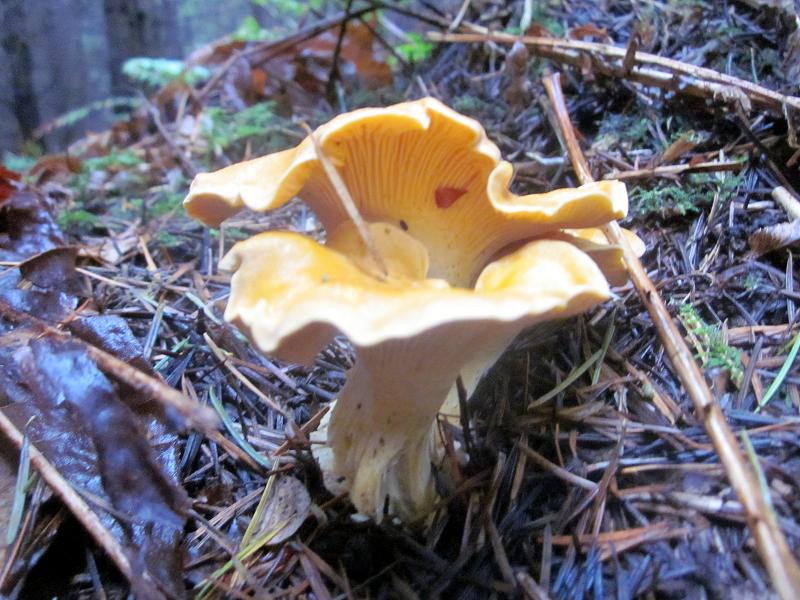 The months of September and October are when chanterelles really make their appearance ‘round here. After a couple days of rain you’ll get quite a bit of growth but the ‘shrooms will be soggy. So the ideal time to go picking is a day or so after the rains have done their work. Early in the morning is best because it avoids traffic, competition and the cougars are drowsy and un-coordinated, possibly from hangovers. Besides, you really feel good getting out there in the crisp silence before your three cups of morning coffee. It’s both exciting and very meditative.
The months of September and October are when chanterelles really make their appearance ‘round here. After a couple days of rain you’ll get quite a bit of growth but the ‘shrooms will be soggy. So the ideal time to go picking is a day or so after the rains have done their work. Early in the morning is best because it avoids traffic, competition and the cougars are drowsy and un-coordinated, possibly from hangovers. Besides, you really feel good getting out there in the crisp silence before your three cups of morning coffee. It’s both exciting and very meditative.
Location, Location, Location!
Knowing where chanterelles congregate is key to a good morning’s harvest. You can easily spend hours in the bush with little to show for your troubles ‘cept an empty stomach and muddy boots. Every savvy picker knows a couple places that will always yield a bucket’s worth, and some will guard their secret spots with near-violent fervor. Be respectful of other pickers, and avoid the really crazy ones… If you see tents amidst the trees, find another forest.
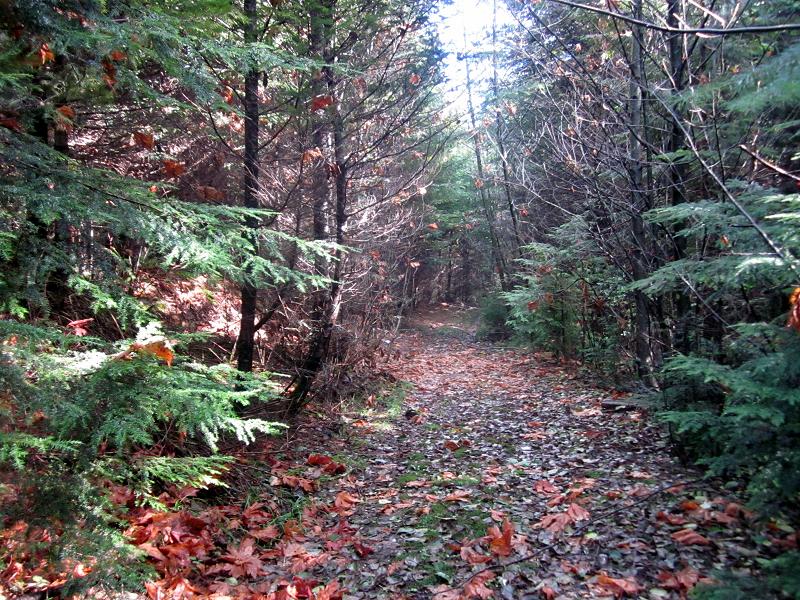 Another thing to mention is that some land is off limits for mushroom picking : Crown Land, National or Provincial parks and reserves, native reservation land and people’s private property. It’s good to square your foraging parameters before you leave the house, and don’t ramble too far outside of it.
Another thing to mention is that some land is off limits for mushroom picking : Crown Land, National or Provincial parks and reserves, native reservation land and people’s private property. It’s good to square your foraging parameters before you leave the house, and don’t ramble too far outside of it.
Toni’s taken me out to some different places in the past, and all of them seem to involve logging roads (both active and abandoned) for reasons that may become clear when you analyze what conditions best enhance chanterelle growth:
Chanterelles grow in clusters on the forest floor amidst decaying wood, moss and pine needles. They prefer a light canopy overhead and usually can be found in the company of lots of other mushrooms, some of which are edible as well. When Toni and I went out she mentioned that all of her favourite spots to pick were “second growth” forests, referring to an area that had been clear-cut a century or so before. The distressed earth following a clear cut is the perfect environment for fungus spores to spread and mature, and the re-planted trees aren’t tall enough yet to completely blot out the sun.
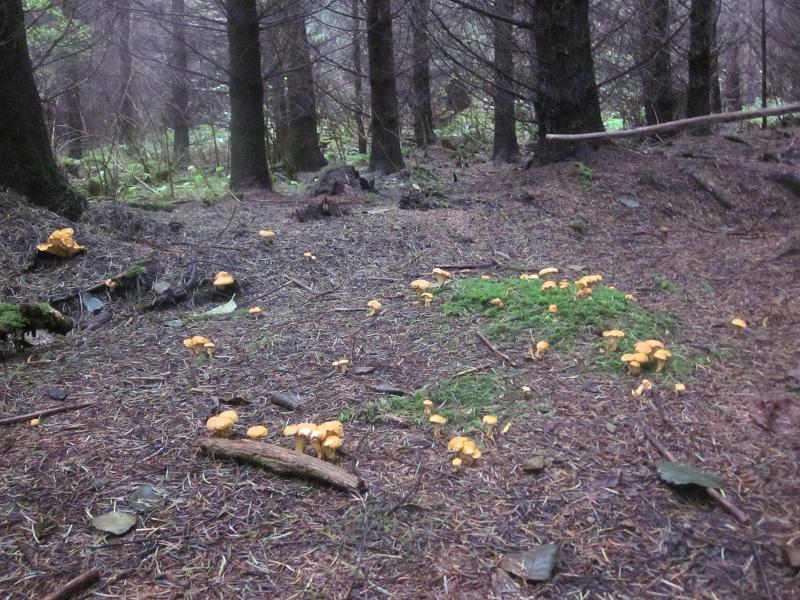
We took our bearings by compass and dove into the brush, stepping over ostrich ferns and devils club (which Toni cut a sliver off of, and it smells like gin!) and made our way to the first of many small clearings full of mushrooms. During our whole excursion we rarely went forty-to-sixty feet from the road, and as I’ve already said, we kept that compass pretty busy!
Identification
Identifying chanterelles is the next big bit of knowledge you need before you forage. If you don’t know what you’re looking for you can easily bring home a bucket of something that will make you sick. Real golden chanterelles are a uniform egg yolk-colour with sometimes ridged/sometimes smooth caps (depending on maturity and growing conditions) and a total lack of gills. What they have instead is a series of wrinkles (false gills) running from the ground level part of the stem up along the underside of the cap. The center of the cap may be domed (in the case of young ones) or with a slight depression as the fungus grows larger. They grow only on the ground or out of fallen or rotting stumps that have decomposed to basically dirt. They don’t grow from trees or felled logs, but can sometimes be found hiding under them.
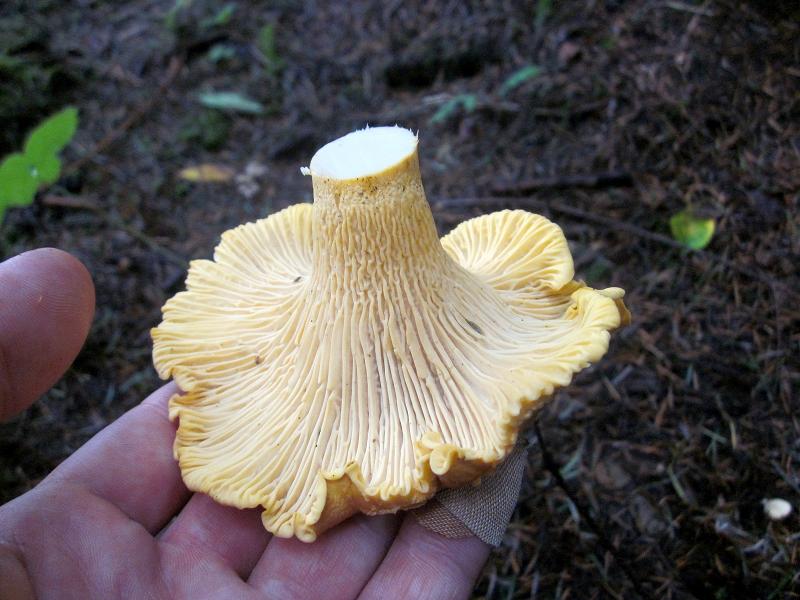
If you’re not sure about the fungus you’re standing over, leave it alone! There are a couple of similar looking triffids that grow around, and look like chanterelles. These won’t kill you outright, but they could give you a serious upset stomach if you make them the main event of an autumn feast. Just imagine what it would do to your gourmet cred if you poisoned your friends… That thought alone should keep you focused.
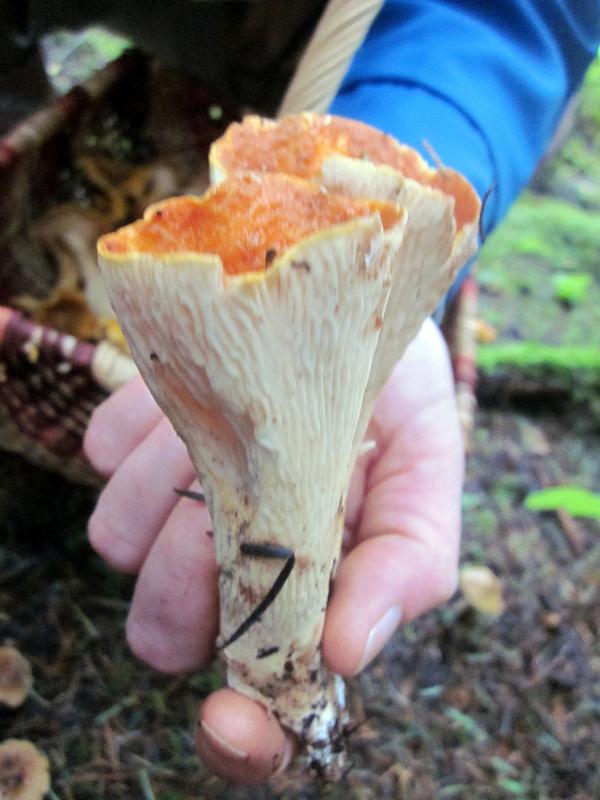
There is a lot of material out there to help you properly identify wild mushrooms. I’ve already mentioned the Westcoast mushroom bible entitled All That The Rain Promises And More by David Arora. It’s the standard, no the quintessential mushroom picker’s guide. The Peterson Field guides and TheNew Savoury guides are also very informative. I always go with a guide that has photos. Good, clear photos! I don’t care how good the recipes in your Lost Buddhist Chocolate and Fungus Foraging Guide are, if the book is hand illustrated… It’s useless to me.
Harvesting
To ensure that each golden nub will continue to sprout edibles it is essential to use a knife to harvest ‘em. Just align your chopper at ground level and saw through the stem. It should make a squeaky sound much like when you chew on cheese curds.
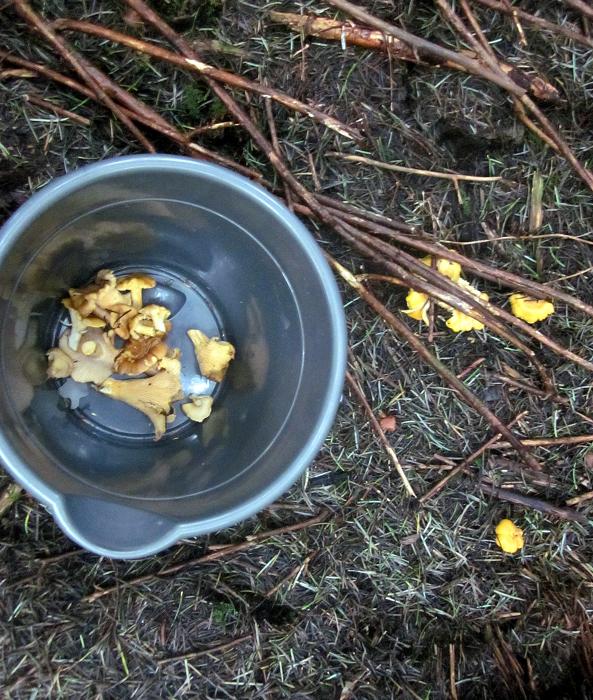 Toni loves the small ones, and I’ve got to agree, they make great sauté material and hold their shape very well. The larger ones remain solid but flake a bit during cooking, especially around their ridged (ie. overdeveloped) edges. The bigger boys are also a lot harder to clean (using a little brush), especially when they grow really curly.
Toni loves the small ones, and I’ve got to agree, they make great sauté material and hold their shape very well. The larger ones remain solid but flake a bit during cooking, especially around their ridged (ie. overdeveloped) edges. The bigger boys are also a lot harder to clean (using a little brush), especially when they grow really curly.
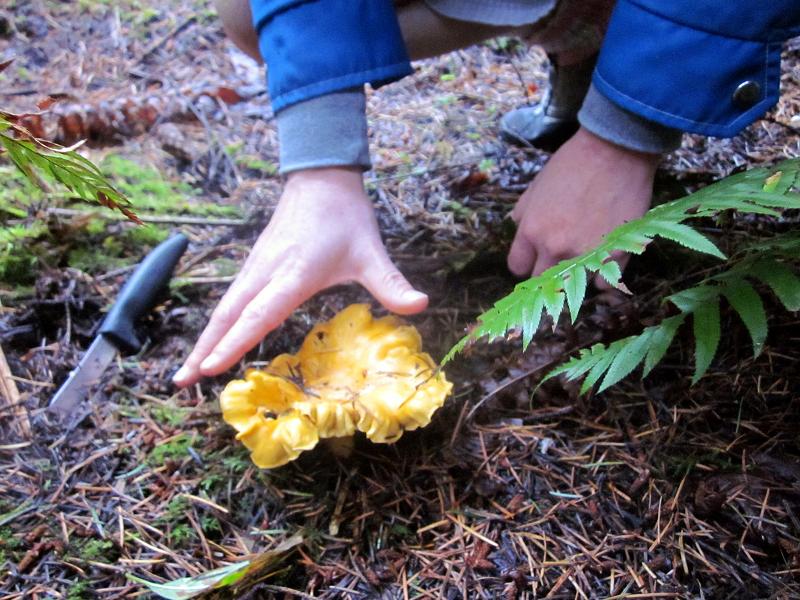 Something to remember while your excitedly harvesting your ‘shrooms is that unless your planning on selling ‘em, you probably won’t eat pound after pound. Keep your selection to just the chanterelles that are solid, not soggy, the right size and shape for your needs, and just enough to feed you and your family. Don’t worry, you can come back to your spot and get some more next week… They’re not going anywhere.
Something to remember while your excitedly harvesting your ‘shrooms is that unless your planning on selling ‘em, you probably won’t eat pound after pound. Keep your selection to just the chanterelles that are solid, not soggy, the right size and shape for your needs, and just enough to feed you and your family. Don’t worry, you can come back to your spot and get some more next week… They’re not going anywhere.
Taste, Texture and Aroma
The best way I can explain the aroma of chanterelles is “sweet and clean”. Faint hints of apricots, almonds and rooibos tea are there, along with a deep, cool underground wellspring ‘kinda aroma. Avoid the ones that smell of mildew, or are soggy from the recent rain. A choice chanterelle will have a firm springy texture and a meaty, dense core of fungus goodness.
After picking them for a while the scent will enter your olfactory cortex and you will be hooked. Toni told me that when she started hardcore foraging she could smell them even while she was riding by on her bike! I suspect she’s part coyote.
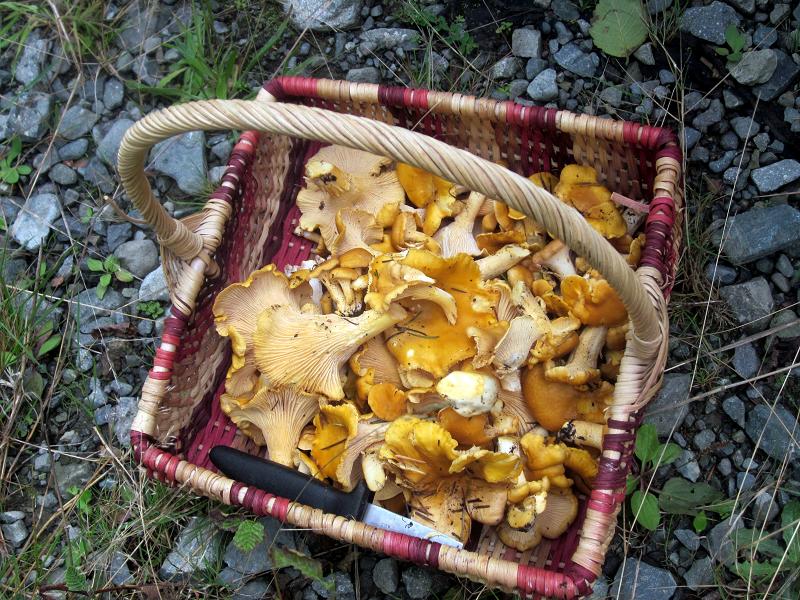 When cooked, chanterelles display a very savoury and slightly nutty profile. As the French have long known they are best friends with fat and only take a couple of minutes immersed in butter or good olive oil to become absolutely transcendent. Shallots and cream are other perfect compliments as is garlic and I suspect ginger and oyster sauce might also play well – Chinese medicine has incorporated chanterelles into homeopathic cooking for centuries. Thanks to their dense texture they can be cooked at high heat and will crisp, perfect for garnishes, sautéed mains, or de-hydration (esp. duxelle).
When cooked, chanterelles display a very savoury and slightly nutty profile. As the French have long known they are best friends with fat and only take a couple of minutes immersed in butter or good olive oil to become absolutely transcendent. Shallots and cream are other perfect compliments as is garlic and I suspect ginger and oyster sauce might also play well – Chinese medicine has incorporated chanterelles into homeopathic cooking for centuries. Thanks to their dense texture they can be cooked at high heat and will crisp, perfect for garnishes, sautéed mains, or de-hydration (esp. duxelle).
Next week I’ll post not one, but two recipes featuring chanterelles that really highlight their versatility. I’m thinking of doing a stuffed chicken breast, and a simple, yet elegant wild mushroom soup. We’ll see.
Big thanks to Toni, who’s expert guidance and orientation skills kept me from not only getting lost in the bush and being cougar-chow, but also expanded my understanding of wild plants and herb-lore and on top of all that, provided me with material enough for many great meals. You are good as gold!
Yeah, that was kind of a chanterelle pun.
Awesome, thanks Shawn!
Just a note: really old second-growth forest is what I look for when scoping for Chanterelle spots… areas that were logged about 100 years ago.
I just re-edited the post to sub “decade” for “century”. It’s only ninety years difference, totally understandable! *laughs*
Last week we were finding healthy Chantrelles in Colorado. I’ve found a new spot but most of the mushrooms have dried. Can I still harvest them and cook? I know they will lose some flavor but is natural drying any thing like dehydrating.
I have a few with me from this morning and would love to make something yummy with them.
Thank you
My rule of thumb is if it looks anything but fresh, don’t pick it.
Having said that, we’ve been experiencing an equally (and surprisingly) super-dry summer and I’ve noticed a lot of shrooms along my usual bike routes that seem almost perfectly dried… I guess my mind goes to crazy places like: “what happens when badger pee soaks into a de-hydrating mushroom over the course of two weeks? Does it become akin to cyanide?” I trust mother nature only so far.
Thank you so much, that’s an insanely good question! I wish I had a better answer. *laughs*
Good luck with dinner and good hunting this autumn!
Excellent article Shawn.
We have been collecting large quantities every week to dehydrate for the time between picking seasons. We actually prefer the dried ones for a lot of cooking. Since we are vegetarians that still like that meaty texture, dried chanterelles are sweet to have around as they have an awesome texture. Plus it is a good money saver over spending $5 a pound in the stores for regular mushrooms.
That’s a really good ‘couple of points! I never even considered how much money can be saved foraging.
How do you dehydrate your ‘shrooms? Do you use the oven? Can they be hung like herbs I wonder…?
Big love.
8 hours in a dehydrator makes them as crispy as potato chips. I had the bright idea of trying to flavour them like salt and vinegar but they only absorbed enough to make them rubbery when dried instead of crispy. I also tried seasoned oil, and although that worked and would be another way to store them, it didn’t work as a snack.